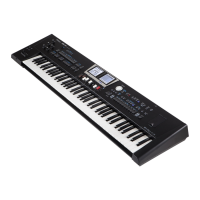Working with the 16-Track Sequencer
90
GLOBAL CHANGE
This function allows you to make quick changes to certain settings.
The changes always apply to entire tracks (you cannot use GLOBAL
CHANGE for just a few measures). Designed to help you “enhance”
Standard MIDI Files, it is a wonderful tool for the following
applications:
• “Upgrading” older Standard MIDI Files to take advantage of the
BK-9’s new sounds.
• Global changes to the Reverb and/or Chorus Send values, which
is very convenient when you suddenly notice that the eect is
too prominent or not strong enough.
Left Display
Right Display
Parameter Setting Explanation
Track All, Trk 1~ Trk 16
Allows you to select the track you
wish to edit. You can also select “ALL”
here, in which case the operation
applies to all tracks.
From CC00
--, 0~127, ALL
This control change is the so
called “MSB” bank select message.
It allows you to select the Capital
Tone (select “0”) of a sound
address if you don’t want to use
variations or to select another
variation level. The “To CC00” value
= 0” can be useful for ensuring
GM compatibility, because that
standard (unlike GM2 or GS) does
not support tone variations.
Select “---” if the current setting
must not change.
To CC00
From CC32
--, 0~127, ALL
This control change is the so
called
“LSB” bank select message.
Select “---” if the current setting
must not change.
To CC32
From PC
--, 1~128, ALL
Use this parameter to change the
program change number, (e.g.
from “1” to “2”).
Select “---” if the current setting
must not change.
To PC
Inc/dec Volume
–127~127
These parameters allow you to
add (+ or subtract (–) a given
value to/from the current Volume,
Expression, Pan, Reverb Send or
Chorus Send values. This may
come in handy if the real-time
changes you recorded turn out to
be too high or too low.
Inc/dec Reverb
Inc/dec Expression
Inc/dec Chorus
Inc/dec Panpot
SHIFT CLOCK
SHIFT CLOCK allows you to shift the notes within the selected
FROM/TO range. It can be used for two things:
• To correct “slow” notes due to a slow(er) attack.
You may want to use SHIFT CLOCK after assigning a sound to
a track that has a considerably slower attack than the sound
you used for recording the part in question. This technique
is frequently used in pop music to “time” 1/16-note string
arpeggios played with a “slow” pad sound.
Rather than have the notes begin at the mathematically correct
time (e.g. 2-1-0), you could shift them to the left (e.g. to 1-4-115),
so that the peak volume of the attack is reached on the next
beat:
Original positions (slow attack,
timing seems o
Shift= –5
(timing sounds OK)
• To correct the timing of notes recorded via MIDI without
quantizing them.
You can use external sequences as raw material for your songs.
Recording such excerpts via MIDI may cause a slight delay (e.g.
5 CPT). If that is not acceptable, use SHIFT CLOCK to “push” the
recorded data to the left (select “–5”). That allows you preserve
any irregularities the original may contain because it was not
quantized.
Left Display
Right Display
Parameter Setting Explanation
Track All, Trk 1~ Trk 16
Allows you to select the track you wish
to edit. You can also select “ALL” here,
in which case the operation applies to
all tracks.
From Bar
For details information see p. 85.
From Beat
From Cpt
To Bar
To Beat
To Cpt
Data Type
ALL, Note,
P.Bender, Control
Change, Program
Change, NRPN,
RPN, CAF,
Allows you to select the data to be
shifted.
Value (Cpt) –4800~4800
This parameter sets the amount by
which the notes are shifted. The value
refers to CPT units (one CPT= 1/120 Q).
Notes on the rst beat of the rst bar
cannot be shifted further to the left,
because that would mean shifting them
to the “0” measure, which doesn’t exist.
If “Data Type” (see above) is set to “Note” the following parameters
are displayed also.
Parameter Setting Explanation
From Note C-~G9
This parameter allows you to set the
note (or lower limit of the note range)
to be copied within the specied
“From”/“To” time range.
To Note C-~G9
This parameter allows you to set the
upper limit of the note range to be
copied within the specied “From”/“To”
time range.
If “Data Type” (see above) is set to “Control Change” the following

